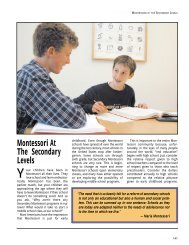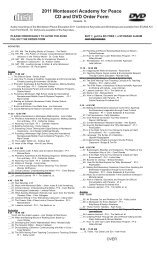Tim Seldin & Paul Epstein Ph.D. An Education for Life
Tim Seldin & Paul Epstein Ph.D. An Education for Life
Tim Seldin & Paul Epstein Ph.D. An Education for Life
You also want an ePaper? Increase the reach of your titles
YUMPU automatically turns print PDFs into web optimized ePapers that Google loves.
MONTESSORI PROGRAMS<br />
50<br />
Montessori teachers work<br />
with three powerful tools:<br />
The first is their knowledge<br />
of child development<br />
and the sensitive periods.<br />
The second is knowing<br />
how to prepare the classroom<br />
environment so<br />
that each sensitive period<br />
is satisfied.<br />
The third is knowing<br />
how to observe.<br />
Montessori Teachers Use Several Principles to<br />
Prepare a Classroom Environment ...<br />
The Principle of Freedom: Children freely choose their own “work” — learning<br />
activities — based on their currently active inner sensitive period. But freedom is<br />
not a free-<strong>for</strong>-all. Instead, the principle here is that of freedom within limits. The<br />
Montessori teacher understands that <strong>for</strong> young children, freedom is an accomplishment<br />
of the development of inner self-discipline. Self-discipline is understood<br />
to be a result of succeeding independently of others. In other words, adults must<br />
never do <strong>for</strong> the child anything that the child can learn to per<strong>for</strong>m <strong>for</strong> him or herself.<br />
Instead, the adult must protect each child’s choice by ensuring that the child<br />
will be able to work with the chosen learning materials without interruption or<br />
interference from other children.<br />
Beauty: Each learning activity is complete; everything needed is present and in<br />
good repair. Objects placed in the classroom are attractive and elegant, designed to<br />
attract the child’s interest and attention.<br />
Contact with Nature and Reality: The classroom objects also represent reality and<br />
nature. Children use real sinks and refrigerators instead of play ones. Because in<br />
real life everyone does not have the same thing at the same time, there is only one<br />
piece of material instead of multiple sets. Dr. Montessori taught that a child’s direct<br />
contact with nature results with understanding and appreciating order and harmony.<br />
The Montessori classroom environment is a place of life. Children learn to take<br />
care of plants, animals, and fish. Magnifying glasses, microscopes, and simple<br />
experiments are available <strong>for</strong> children to observe and learn from nature.




